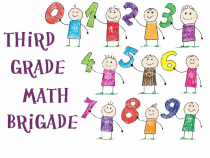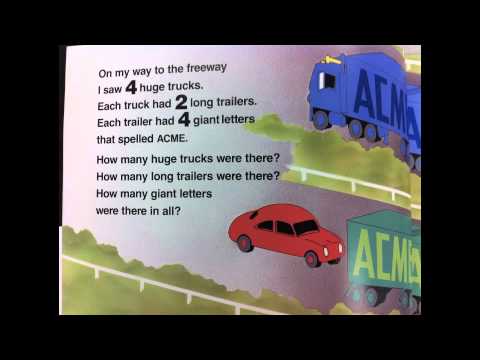Objective:
I can solve and write my own multiplication word problems.
Standard: CCSS.Math.Content.3.OA.A.3
Use multiplication and division within 100 to solve word problems in situations involving equal groups, arrays, and measurement quantities, e.g., by using drawings and equations with a symbol for the unknown number to represent the problem.
Task Analysis:
The teacher will read Each Orange Had 8 Slices aloud to the class. Each page describes a scene with groups of objects and asks questions in multiplicative word problem format. After reading each page, the teacher will pause and ask the students for insight about the posed problem. Each problem will be solved by the whole class.
After the read-aloud, the teacher will ask students to individually create their own page to add to the book. Each student will be given a template to fill out and illustrate.
(Template preview and PDF download available below!)
Materials:
- Each Orange Had 8 Slices
- template for each student
Thinking Levels
Bloom’s Taxonomy:
- Knowledge: The students will solve word problems given in the book.
- Comprehension: The students will create their own multiplication word problems and correctly solve them.
Multiple Intelligences:
- Visual: The students will observe written problems and illustrations
in the book.
- Kinesthetic: The students will create their own illustrated word problems using the template.
- Logical: The students will create and solve multiplication word problems.
Closure: The students' word problem pages will be compiled into a class book and then read aloud to the class and discussed in the same fashion as the original book was.
Benefits: This activity integrates reading into a math lesson. It also integrates art (illustrations for their word problems) and allows the students to be creative with their math by coming up with their own problems rather than solving a textbook's. The presentation of the book is very beneficial in identifying multiplication as a real-world grouping of objects. The book is also catchy and visually appealing to students who won't even realize it's a math lesson!
I can solve and write my own multiplication word problems.
Standard: CCSS.Math.Content.3.OA.A.3
Use multiplication and division within 100 to solve word problems in situations involving equal groups, arrays, and measurement quantities, e.g., by using drawings and equations with a symbol for the unknown number to represent the problem.
Task Analysis:
The teacher will read Each Orange Had 8 Slices aloud to the class. Each page describes a scene with groups of objects and asks questions in multiplicative word problem format. After reading each page, the teacher will pause and ask the students for insight about the posed problem. Each problem will be solved by the whole class.
After the read-aloud, the teacher will ask students to individually create their own page to add to the book. Each student will be given a template to fill out and illustrate.
(Template preview and PDF download available below!)
Materials:
- Each Orange Had 8 Slices
- template for each student
Thinking Levels
Bloom’s Taxonomy:
- Knowledge: The students will solve word problems given in the book.
- Comprehension: The students will create their own multiplication word problems and correctly solve them.
Multiple Intelligences:
- Visual: The students will observe written problems and illustrations
in the book.
- Kinesthetic: The students will create their own illustrated word problems using the template.
- Logical: The students will create and solve multiplication word problems.
Closure: The students' word problem pages will be compiled into a class book and then read aloud to the class and discussed in the same fashion as the original book was.
Benefits: This activity integrates reading into a math lesson. It also integrates art (illustrations for their word problems) and allows the students to be creative with their math by coming up with their own problems rather than solving a textbook's. The presentation of the book is very beneficial in identifying multiplication as a real-world grouping of objects. The book is also catchy and visually appealing to students who won't even realize it's a math lesson!
| each-orange-had-8-slices.pdf |


 RSS Feed
RSS Feed
